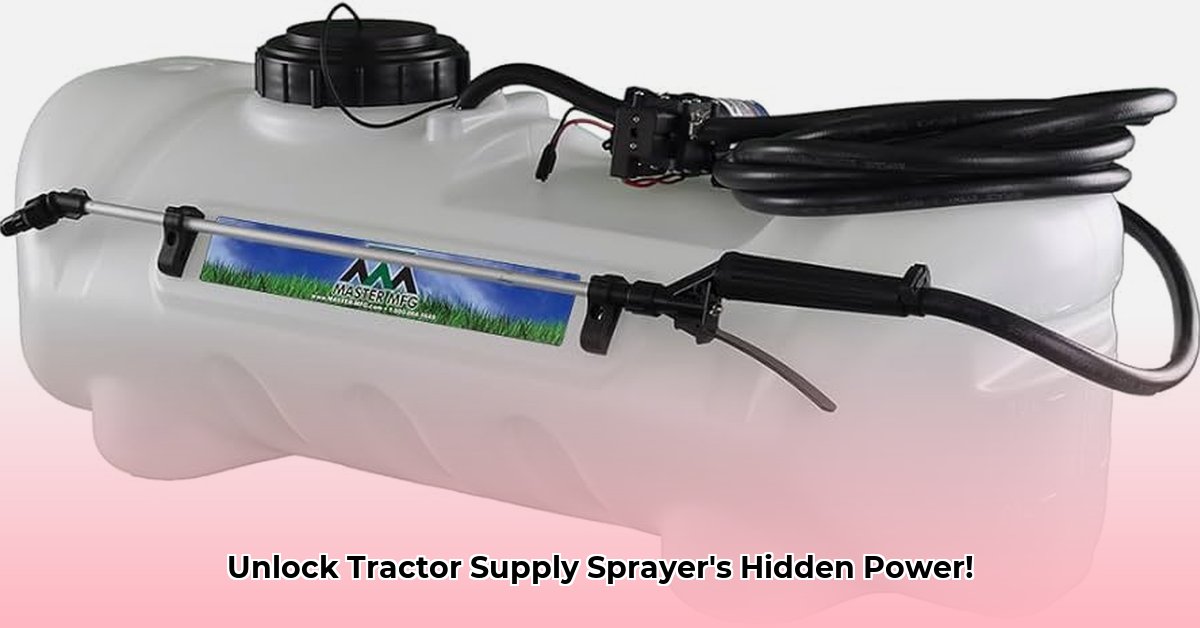
Tractor Supply 15-Gallon Sprayer: Your Path to Sustainable and Profitable Farming
The Tractor Supply 15-gallon sprayer is more than just a piece of equipment; it's a tool that can significantly enhance the efficiency and sustainability of your farming operation. For more information on larger models, check out this helpful resource on taller sprayers. This guide provides a comprehensive overview of its use, from setup and calibration to maximizing its potential for environmentally responsible and profitable agriculture. By mastering precision spraying techniques, you can reduce chemical use, protect beneficial insects, and achieve greater crop yields – ultimately increasing your return on investment (ROI).
Getting Started: Understanding Your 15-Gallon Sprayer
Before you begin, familiarize yourself with the sprayer's features and specifications. Understanding its capabilities is the first step to leveraging its full potential for sustainable farming. The 15-gallon capacity makes it ideal for spot treatments and smaller areas, minimizing waste and maximizing efficiency. "Knowing your sprayer's limitations is as important as knowing its strengths," advises Dr. Emily Carter, Professor of Agronomy at the University of Illinois. This ensures you select appropriately sized equipment for the task.
Key Features and Specifications
- Capacity: 15 gallons (ideal for spot treatments and smaller areas)
- Pressure Settings: (Variable – check manufacturer specifications for exact range) Higher pressure allows greater reach, but lower pressure is gentler on plants.
- Nozzle Types: (Multiple options available; manufacturer's instructions should list compatibility). Consider various spray patterns (cone, flat-fan) depending on your crop and target pest or weed.
- Accessories: (Check compatibility). Consider additional accessories like GPS integration or extension wands for improved reach.
Setting Up and Calibrating Your Sprayer: A Step-by-Step Guide
Proper setup and calibration are crucial for effective and efficient spraying. This ensures your application is precise, minimizing chemical waste and maximizing the effectiveness of treatment. Improper calibration can lead to wasted product and inconsistent results. "Calibration is fundamental to any successful spraying operation," explains John Miller, a leading agricultural extension specialist at Purdue University.
Step 1: Assembly: Carefully unpack your sprayer, following the manufacturer's instructions. Ensure all connections are tight and secure, preventing leaks.
Step 2: Solution Mixing: Always follow the chemical label instructions precisely, ensuring the correct ratio of chemical to water. Accurate measurement is critical for both effectiveness and plant health.
Step 3: Pressure Test: Before attaching the wand, conduct a pressure test to check for leaks. This prevents wasted solution and hazardous spills.
Step 4: Calibration: Spray a measured area (e.g., 10 square feet) to determine the solution output rate. Adjust pressure and walking speed to achieve the desired application rate. Maintain consistent speed and pressure for even coverage. This step is vital for efficient chemical use and optimal results.
Step 5: Nozzle Selection: Choose the appropriate nozzle for your specific needs based on the target pest or weed and the chemical being applied. Consult the pesticide label for nozzle recommendations and consider factors such as droplet size and spray pattern to minimize drift.
Sustainable Spraying Techniques: Minimizing Environmental Impact
Sustainable agriculture is about maximizing efficiency and minimizing environmental impact. Precision spraying is a vital tool in achieving this goal. "Sustainable agriculture requires innovative practices that protect our natural resources while ensuring economic viability," says Dr. Sarah Chen, Agricultural Sustainability Consultant.
Reduced Chemical Use: Spot spraying allows you to target specific areas, significantly reducing overall chemical usage compared to blanket spraying. This reduces environmental impact, protects beneficial insects, and lowers your costs.
Targeted Application: Precise application minimizes chemical drift, protecting surrounding areas and beneficial insects. This is particularly important to avoid contamination of water sources and non-target areas.
Optimized Timing: Apply chemicals at the optimal growth stage of weeds or pests for maximum effectiveness and reduced chemical usage. Knowing the life cycle of your target pest is key for minimizing the resources needed for control.
Integrating Technology for Enhanced Precision
Integrating technology can significantly enhance the precision and efficiency of your spraying operation. This allows for more data-driven decision-making and can further contribute to sustainable agricultural practices.
GPS Integration: GPS-guided spraying allows for precise mapping of sprayed areas, preventing overlaps and wasted chemicals. This feature significantly increases efficiency and reduces chemical use. The investment in GPS technology often pays for itself in chemical savings.
Data Logging: Track application data, such as area covered, chemical used, and application rates, for better planning and future reference. This data greatly assists in optimizing spraying operations and improving efficiency.
Maintenance and Care: Extending the Life of Your Sprayer
Proper maintenance is crucial to extend the life and efficient operation of your sprayer. Regular maintenance prevents costly repairs and ensures consistent performance.
Thorough Cleaning: Clean the tank and all components thoroughly after each use to prevent residue buildup and clogging.
Smart Storage: Store the sprayer in a dry, protected location away from extreme temperatures and direct sunlight.
Regular Inspections: Regularly inspect the sprayer for any damage, leaks, or worn parts. Replace worn components promptly.
Cost-Benefit Analysis: Your ROI on Sustainable Practices
While there's an upfront cost, the long-term benefits of precision spraying often exceed the initial investment.
Chemical Cost Savings: Precision application significantly reduces chemical usage, leading to lower expenses.
Improved Yields: Effective pest and weed control promotes healthier plants and potentially higher yields.
Environmental Benefits: Sustainable practices improve your farm's sustainability profile, potentially attracting eco-conscious consumers.
Conclusion: Embracing Sustainable and Profitable Farming
The Tractor Supply 15-gallon sprayer is a valuable tool for sustainable and profitable farming. Its efficient application capabilities help reduce chemical usage, improve crop health, and ultimately increase your return on investment. By understanding its capabilities and implementing the practices outlined in this guide, you can transform your farming operation towards a more efficient and environmentally conscious future. Remember that continuous learning and adaptation are key to maximizing the benefits of your sprayer and your overall farming practices.